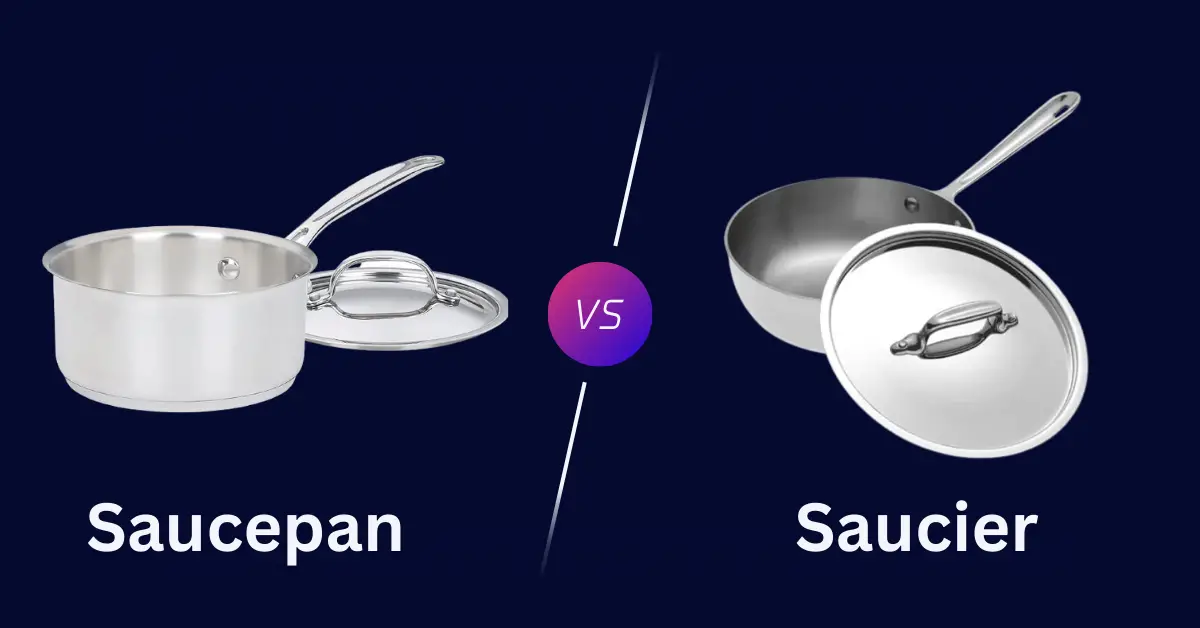A Saucier is a skillet of medium size used for preparing sauces. On the other hand, a Saucepan is a deep and broad cooking pot used to cook over low heat or store food or reheat leftovers. Let’s see more differences between them.
Saucepan vs. Saucier

| Sauce Pan |
|---|
| Shape: A saucepan is a straight-sided, deep cooking vessel with a long handle. |
| Function: A saucepan is generally used for cooking liquids, such as making sauces, boiling pasta, or heating up soup. |
| Capacity: Saucepans tend to have a higher capacity than sauciers. It can hold between 2 and 4 quarts of liquid. |
| Heat distribution: Can’t heat distributed evenly from all sides because the sidewall is straight. |
| Cooking techniques: Saucepans are better for boiling, steaming, and simmering, and can also be used for sautéing or frying. |

| Saucier |
|---|
| Shape: A saucier has sloping sides that curve inward at the bottom and a wider opening. |
| Function: A saucier, on the other hand, is specifically designed for making sauces, as the curved shape allows for better mixing and whisking of ingredients. |
| Capacity: A saucier usually has a capacity of 1 to 3 quarts. |
| Heat distribution: Sauciers are designed to distribute heat evenly, thanks to their rounded bottom. This makes them great for delicate sauces that require constant stirring. |
| Cooking techniques: Sauciers are particularly well-suited for techniques that require constant stirring, such as making custards or cream-based sauces. |
Which is better, the saucier or the saucepan?
Choosing between a saucier and a saucepan depends on the specific cooking task and personal preference. Both have their advantages and are designed for different purposes in the kitchen. Let’s explore the characteristics of each to help you make an informed decision.
Saucier
A saucier, also known as a saucière or sauté pan, is a shallow, wide-bottomed pan with sloping sides and a long handle. It is specifically designed for making sauces, gravies, reductions, and other liquid-based recipes that require frequent stirring and precise temperature control.
The curved shape of the saucier allows for easy whisking and stirring, ensuring even heat distribution and preventing the sauce from sticking to the corners of the pan. The sloping sides also make it convenient to pour the sauce without any drips or spills.
Saucepan
A saucepan is a deeper, narrower vessel with straight sides and a handle. It is a versatile tool that can be used for various cooking tasks, including boiling water, cooking soups, stews, rice, and pasta, as well as making smaller quantities of sauces.
The straight sides of a saucepan provide more surface area for evaporation, making it suitable for reducing liquids or simmering ingredients for extended periods.
When it comes to choosing between a saucier and a saucepan, consider the following factors:
- Purpose: If your primary focus is preparing sauces, a saucier is specifically designed to offer better control and ease of stirring.
- Versatility: A saucepan may be a more practical choice if you require a multi-purpose tool that can handle different cooking tasks beyond sauces.
- Quantity: Sauciers are typically available in smaller sizes, making them suitable for preparing smaller quantities of sauces. If you often cook larger batches of sauces or other recipes, a saucepan with its greater capacity may be more convenient.
Ultimately, the “better” option between a saucier and a saucepan depends on your specific needs and preferences. It’s worth noting that both can be valuable additions to a well-equipped kitchen, and many chefs and home cooks find both to be essential tools for different cooking applications.
Depending on what types of dishes you cook, you can choose what will suit you. If you need both types of pans in your arsenal, it might as well be in your kitchen.
Can a saucier replace sauce pan?
Yes, a saucier can replace a saucepan as it is specifically designed for making sauces and has a curved bottom for easy stirring and whisking.
What do you use a saucier pan for?
A saucier pan is used for making sauces, custards, and other delicate recipes that require precise temperature control and even heat distribution.
What are the advantages of a saucier?
1) Even Heat Distribution: The saucier’s curved shape and wide base promote even heat distribution.
2) Precise Temperature Control: The rounded bottom allows for easy whisking and stirring, preventing sauces from sticking or burning while providing greater control over heat adjustments.
3) Versatile Cooking: Besides sauces, a saucier can be used for tasks such as melting chocolate, making custards, reheating leftovers, and preparing gravies.
4) Pouring Convenience: The saucier’s rounded lip makes it easier to pour sauces or liquids without drips or spills.
5) Easy Cleanup: The saucier’s smooth interior and rounded corners make it simple to clean, as there are no hard-to-reach edges or crevices to trap food.
You may also love to read: All-Clad Vs. Scanpan: Differences & Similarities
What is the healthiest type of saucepan?
The healthiest saucepan type does not react with the food being cooked, is easy to clean, and heats evenly. Some of the top choices include:
Stainless steel saucepans – These pans are durable, non-reactive, and heat evenly.
Cast iron saucepans – These pans have great heat retention and even cooking but can be heavy.
Ceramic-coated saucepans are non-stick and non-reactive but may require extra care to maintain the coating.
Anodized aluminium saucepans are non-stick and heat evenly but may be less durable over time.

What type of saucepans do chefs use?
Chefs often use a variety of saucepans depending on their needs and preferences. Some of the most commonly used saucepans include:
Stainless Steel Saucepan – Durable and non-reactive – Even heat distribution
Cast Iron Saucepan – Superior heat retention – Perfect for slow cooking
Aluminium Saucepan – Lightweight and affordable – Heats up quickly
Clad Saucepan – Combines benefits of multiple materials – Great overall performance
Hard-Anodized Aluminum Saucepan – Resistant to scratches and corrosion – Excellent heat distribution
In conclusion, the type of saucepan a chef chooses largely depends on the dish they are preparing and their preferences. Each saucepan material has pros and cons, making it important to consider the cooking task before selecting the most suitable saucepan. By the way do you have any fav chefs?
Can you boil pasta in a saucier?
Yes, you can boil pasta in a saucier. A saucier is a versatile cookware item perfect for cooking various dishes, including boiled pasta.
Can you deep fry in a saucier?
No, deep frying in a saucier is not recommended for several reasons:
Safety concerns
- Sauciers have sloping sides making them less stable for deep frying.
- The curved design may cause hot oil to spill when adding or removing food.
Cooking performance
- The shape of a saucier makes it difficult to maintain consistent oil temperature.
- A flat-bottomed pot is more suitable for an even distribution of heat.
Alternatives
- Use a deep, straight-sided pot or a designated deep fryer for better results.
- Opt for shallow frying in a saucier if an alternative is not available.
In conclusion, while frying in a saucier deep is possible, it is not recommended due to safety risks and compromised cooking performance. To ensure a successful and safe deep frying experience, choose appropriate cookware such as a deep, straight-sided pot or a designated deep fryer.
What is a saucier also known as?
A saucier, often called the sauce chef or sauce maker, is a highly skilled culinary professional responsible for creating and overseeing the preparation of sauces, soups, and other liquid-based dishes in a professional kitchen.
What are the requirements for a saucier?
A saucier is important in a professional kitchen, responsible for creating and preparing various sauces, soups, and stews. To become a successful saucier, one should possess the following skills and qualifications:
1) Culinary education: A degree or diploma in culinary arts can provide the technical knowledge and skills necessary for this role.
2) Cooking experience: Prior experience in a professional kitchen, especially in a position responsible for sauces, is essential.
3) Knowledge of ingredients: A keen understanding of various ingredients’ flavours, properties, and uses is crucial for creating delicious sauces.
4) Creativity: Combining flavours, textures, and ingredients uniquely and innovatively is a valuable skill for a saucier.
Saucepan vs. Saucier: 3 Key Differences and Why You Don’t Need Both

I am Linda. A housewife and a writer, and also the founder of this site. I love cooking and collecting cookware sets. I’ve been blogging since 2020, and in this blog, you can find cookware-related problems and solutions, cookware reviews, safe cookware sets, and more.
I have put a lot of effort into gathering here the experience and knowledge that I have, and I want to help every reader.

